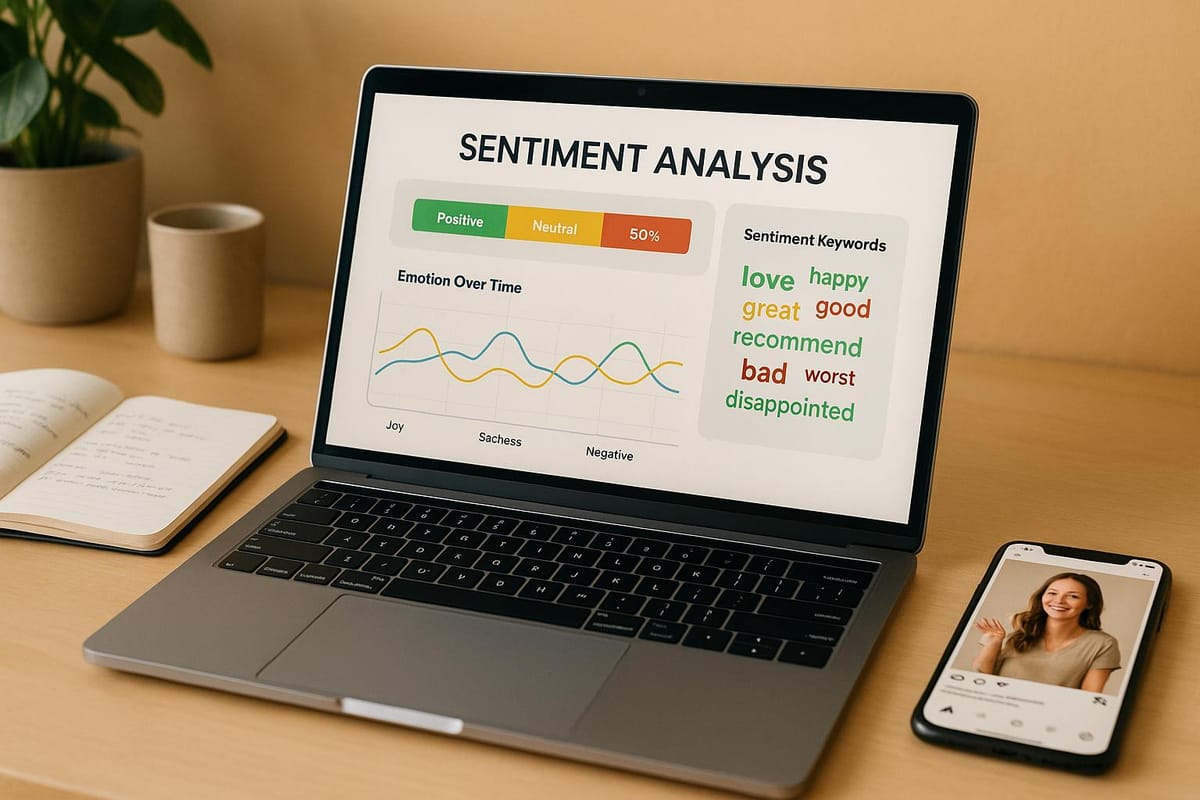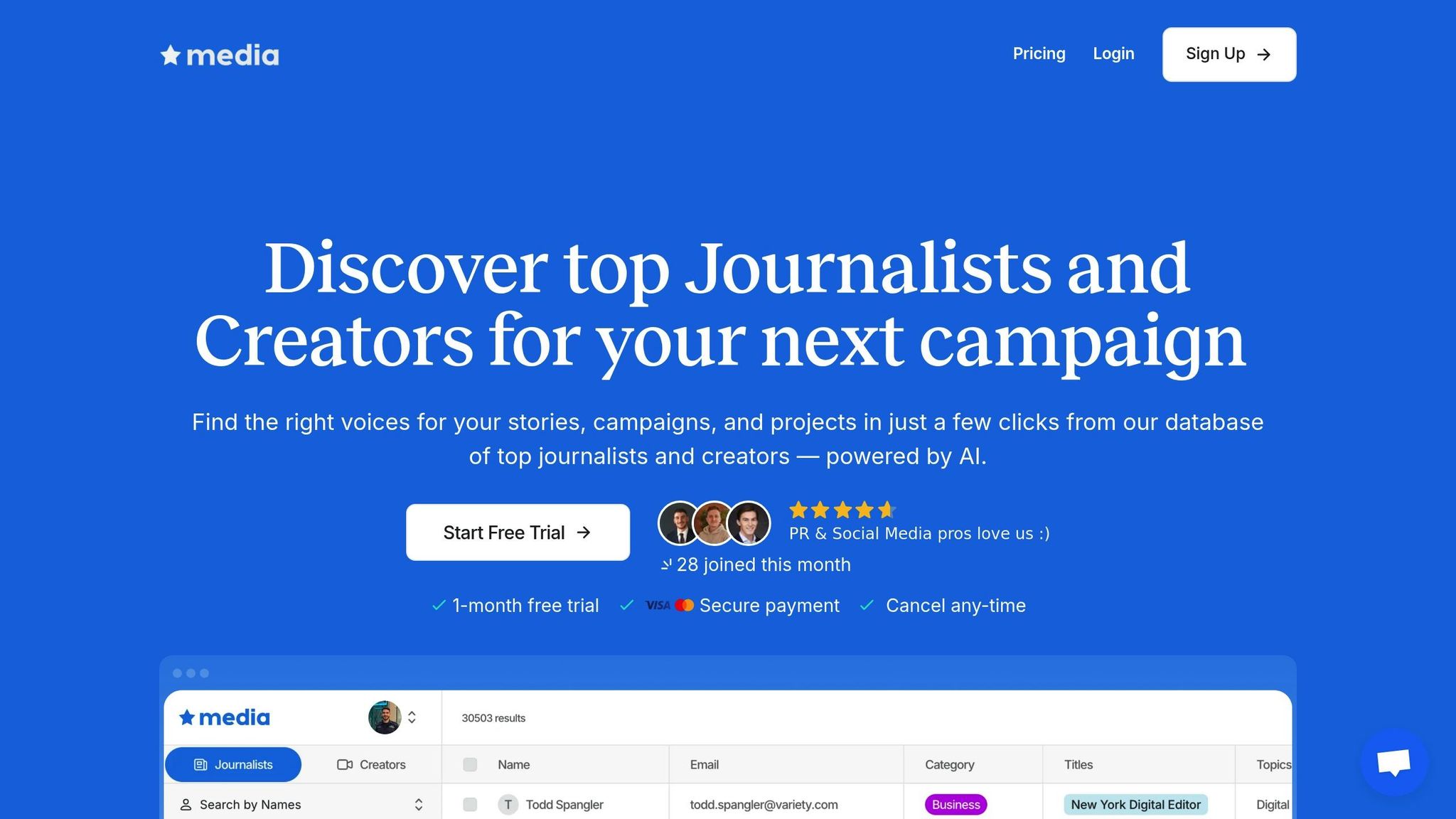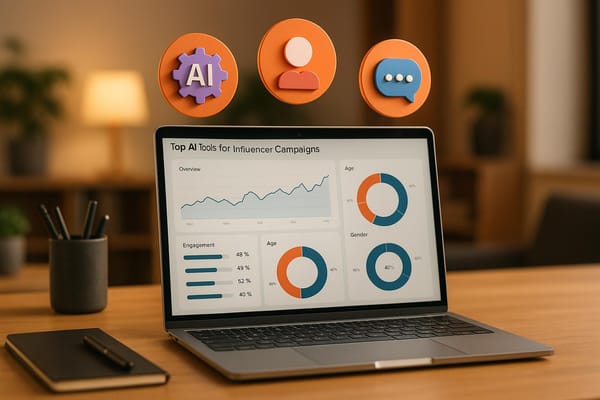How Sentiment Analysis Personalizes Influencer Outreach
Explore how sentiment analysis enhances influencer outreach by aligning emotional connections with brand messaging for greater campaign success.

Sentiment analysis helps brands understand how audiences feel about influencer content, products, or campaigns. By analyzing emotional tones in comments, reviews, and captions, it categorizes reactions as positive, neutral, or negative. This data enables marketers to:
- Select influencers whose audience emotions align with their brand.
- Create personalized outreach messages that resonate emotionally.
- Monitor audience reactions in real time to adjust campaigns if needed.
For example, brands like Nike and Airbnb have used sentiment analysis to track public opinion during campaigns, ensuring their messaging connects with audiences. Tools like Media AI simplify this process by providing a database of influencers and real-time sentiment insights, helping brands move beyond surface-level metrics like likes or followers.
With influencer marketing projected to reach $33 billion globally by 2025, incorporating sentiment analysis into outreach strategies is becoming essential for brands looking to maximize their impact and ROI.
Understanding Sentiment Analysis in Influencer Marketing
What is Sentiment Analysis
Sentiment analysis, powered by AI and natural language processing (NLP), is like a digital mood ring for text. It identifies the emotional tone behind written content, categorizing it as positive, neutral, or negative. What makes this technology stand out is its ability to go beyond basic word recognition - it picks up on subtleties like sarcasm, emojis, and context.
In the context of influencer marketing, sentiment analysis helps brands understand how audiences emotionally react to specific content, products, or topics. Instead of just looking at engagement numbers, brands can uncover the real emotions driving audience interactions.
One of its biggest advantages? It works in real time. Marketers can track audience reactions as they happen, giving them the chance to address issues quickly and tweak messaging before things spiral out of control. With algorithms now achieving 80–90% accuracy, sentiment analysis has become a dependable tool for making informed marketing decisions. Plus, it’s becoming more accessible - 19% of marketers are already dedicating 40% of their budgets to AI technologies.
Why Sentiment Analysis Matters for Influencer Campaigns
In influencer marketing, emotions are everything. People tend to respond emotionally before they think rationally, and these initial feelings often shape their decisions. With 72% of consumers engaging only with messages tailored to their preferences, sentiment analysis ensures campaigns hit the right emotional notes.
This technology also helps brands confirm that their tone resonates with their audience. Even more importantly, it allows brands to collaborate with influencers who genuinely connect with their followers on an emotional level.
Take Nike’s "Dream Crazier" campaign as an example. Nike used sentiment analysis to monitor social media reactions in real time, identifying which messages and athletes sparked the most positive responses. The campaign, narrated by Serena Williams and featuring female athletes, tackled gender stereotypes in sports. By tracking sentiment, Nike navigated potential controversies and kept the campaign on track.
Similarly, Airbnb’s "We Accept" campaign highlights how sentiment analysis can help during a crisis. After facing accusations of discrimination, Airbnb used this tool to gauge public opinion and address the backlash. The campaign not only helped repair their reputation but also reinforced their commitment to anti-discrimination efforts.
The numbers show how important this technology has become. The global sentiment analytics market is projected to hit $7.5 billion by 2028, while the influencer marketing industry itself is expected to grow to over $33 billion globally by 2025.
Another benefit of sentiment analysis is its role in campaign evaluation. Instead of relying solely on metrics like reach or clicks, brands can include sentiment data in their post-campaign reviews. This provides a deeper understanding of how audiences truly felt about the campaign, offering a more rounded view of its success.
Up next, we’ll dive into how you can use these insights to create more targeted influencer outreach strategies.
Steps to Apply Sentiment Analysis in Influencer Outreach
Analyzing Influencer Content and Audience Reactions
The first step in using sentiment analysis for influencer outreach is gathering and evaluating data from potential collaborators. The goal is to understand both the influencer's content and the emotional tone of their audience's reactions.
Start by reviewing the influencer's recent posts across their main platforms. Don’t just focus on surface-level metrics like likes and shares - dig deeper into the emotional tone of the comments. Are followers showing excitement, curiosity, or even skepticism? This deeper analysis reveals whether the influencer's audience is actively engaged or simply scrolling past their content.
Pay special attention to how their audience responds to previous brand collaborations. This can help identify which tone or style resonates most with their followers and drives meaningful engagement.
To take it further, set up tracking systems to monitor sentiment trends on key topics related to your brand. Web scraping tools can help collect data on metrics like like-to-share ratios, post longevity, and overall sentiment patterns. This can also reveal any potential red flags, such as negative or controversial feedback about the influencer that might not be immediately obvious.
Monitoring sentiment isn’t just useful before a campaign - it’s critical during one too. For example, in one case, a client paused a product launch mid-campaign after sentiment analysis revealed confusion about how to use the product. A quick how-to post was created, turning the situation around and boosting conversions.
This type of analysis ensures you’re choosing influencers whose content and audience sentiment align well with your brand's values and goals.
Using Sentiment Data to Select Influencers
Once you’ve analyzed audience sentiment, use these insights to make smarter decisions about which influencers to partner with. This approach shifts the focus from vanity metrics like follower counts to measuring genuine emotional impact.
Look closely at the tone of comments and feedback on an influencer's posts. High engagement numbers might look impressive, but they don’t always tell the full story - positive sentiment is a much stronger indicator of influence. One brand discovered that its most effective influencers weren’t the ones with the largest followings but those generating the most positive reactions.
Before committing to a partnership, review the sentiment surrounding the influencer's past collaborations. This will help ensure they align with your brand values and avoid any potential missteps that could harm your reputation or fail to connect with your audience.
Many major brands now rely on sentiment data to guide their influencer selection process and manage campaigns effectively. Setting up sentiment analysis trackers on influencers’ social media accounts before making partnership decisions can provide a more informed and strategic approach.
Creating Personalized Messages with Sentiment Insights
After identifying the right influencers, use the sentiment insights you’ve gathered to craft personalized outreach messages that emotionally resonate with them and their audience.
Analyze the data to pinpoint topics or content styles that drive positive engagement. For example, if an influencer’s followers respond better to behind-the-scenes content than to polished product shots, tailor your proposal to highlight this preference.
Timing is equally important. Use sentiment patterns to determine when an influencer’s audience is most receptive to brand partnerships. This might be after personal updates, during industry trends, or when specific topics are trending.
Share these insights with influencers to encourage collaboration. By showing them how their audience reacts to different types of content, you’re not just asking for a service - you’re providing valuable data that can enhance their performance while helping you achieve your campaign goals.
For even more precision, segment sentiment data by demographics. For instance, a beauty brand might discover that an influencer’s younger followers prefer tutorial-style videos, while older followers favor lifestyle-focused posts.
Finally, monitor campaigns closely using dashboards and alerts to stay ahead of any shifts in sentiment. Weekly sentiment checks can help you capitalize on positive momentum or address negative feedback quickly. If negative sentiment starts to rise, you can adjust your messaging or content format in real time to protect the campaign’s overall performance.
Using Media AI for Sentiment-Based Influencer Outreach

Media AI Features for Influencer Marketing
Media AI offers a database of over 30,000 creators, powered by advanced AI tools that let you filter by content themes, engagement trends, and past collaborations. It also includes export features to organize sentiment-based influencer research into actionable contact lists. In simple terms, this means you can quickly pinpoint influencers who consistently spark positive emotions around topics tied to your brand - saving you the hassle of combing through profiles and old posts manually.
The platform ensures you're reaching out to active creators with up-to-date contact details and real-time engagement insights. This is especially important in an ever-changing digital landscape where audience preferences can shift overnight. These tools make sentiment-based influencer outreach faster and more efficient, all while fitting neatly into your existing workflow.
"Sentiment analysis helps you read between the lines. It dives into the emotional tone of comments, captions, shares - even emojis - and tells you what your audience is really thinking, to categorize audience reactions."
- Cam Khaski Graglia
Another standout feature is Media AI's no-contract pricing model, which is perfect for testing sentiment-driven strategies. You can access the entire database for $149/month or choose specialized access for either journalists or creators at $99/month each. This flexibility allows you to experiment with sentiment analysis without being tied to long-term commitments. Combined with its robust data and export options, the platform gives you the tools to craft more targeted and effective outreach strategies.
How Media AI Improves Influencer Outreach
Media AI takes influencer outreach to the next level by simplifying data integration and offering real-time sentiment insights. Instead of bouncing between platforms like Instagram, TikTok, and YouTube to gauge audience reactions, its centralized database helps you zero in on the best candidates efficiently.
The AI-driven insights reveal which creators are most likely to evoke positive emotions in their audiences. This matters because 72% of consumers only engage with personalized messages, making sentiment-based personalization a must for successful campaigns.
By offering a structured approach to influencer selection, Media AI helps you move beyond guesswork or surface-level metrics. You can build repeatable processes that align creators' audience sentiment patterns with your campaign goals. This is a powerful advantage, especially when 19% of marketers are allocating 40% of their budgets to AI technologies.
The platform also makes it easy to track your sentiment analysis findings. You can create custom lists of influencers based on sentiment criteria, monitor your outreach progress, and keep detailed records of which emotional tactics work best with specific creators.
Media AI doesn’t stop at helping you launch campaigns - it also supports ongoing optimization. The platform lets you track sentiment performance across various influencers, allowing you to identify those who consistently generate positive reactions. This helps you build long-term relationships with creators whose values and audience sentiment align with your brand.
Finally, Media AI’s export functionality integrates seamlessly with your existing tools, like email marketing platforms or CRM systems. This means you can take the sentiment insights you’ve gathered and apply them directly to your campaigns without the hassle of manual data transfers. It’s a streamlined way to turn data into action.
Measuring Results and Improving Your Outreach Strategy
Key Metrics for Campaign Success
Tracking the right metrics is key to making the most of your influencer outreach efforts. With influencer marketing expected to hit at least $24 billion by 2025, understanding how to measure success can give you a real edge.
Engagement rates are often the go-to metric, but sentiment analysis offers a deeper layer of understanding. It’s not just about counting likes or comments - it’s about evaluating the tone of those interactions. For example, 10,000 comments with 80% positivity have a far greater impact than 15,000 comments with only 40% positivity. This added context helps you see whether your campaign is genuinely resonating with your audience.
Another key metric is tracking sentiment shifts over time. By monitoring how people feel about your brand before, during, and after an influencer collaboration, you can assess whether your campaign is improving perceptions. This is especially useful for initiatives like brand reputation management or launching a new product.
Sentiment analysis also sharpens your return on investment (ROI) calculations. More than 80% of brands believe influencer marketing attracts high-quality customers. Incorporating sentiment data into your ROI assessments helps you identify which influencers are truly elevating your brand’s image and contributing to both immediate sales and long-term value. Essentially, sentiment insights let you measure not just sales but also the emotional connection your brand fosters over time.
Additionally, sentiment-driven messaging outperforms generic outreach by improving response rates. Monitoring sentiment across social platforms as influencer content circulates provides a clearer picture of your campaign’s broader impact and effectiveness.
These metrics are the building blocks for refining your strategy, which leads us to the next step.
Using Ongoing Sentiment Monitoring to Improve Campaigns
Sentiment monitoring isn’t a one-and-done task - it’s an ongoing process that keeps your influencer strategy adaptable and effective. With 94% of B2B marketers reporting success with influencer marketing, staying flexible and proactive can give you a competitive edge.
Conducting weekly sentiment check-ins allows you to tweak your messaging, visuals, or tone in real time. After a campaign wraps up, analyzing sentiment trends can reveal what worked and what didn’t, helping you fine-tune future outreach efforts to better connect with your audience.
Regular sentiment reports also uncover trends and opportunities across your influencer network, keeping your strategy agile. For example, using sentiment data in A/B testing - whether it’s for different ad placements, formats, or messages - can help you identify what resonates most effectively.
Tracking sentiment over time also provides valuable insights into influencer performance. By identifying creators who consistently generate positive emotional responses, you can focus on building long-term partnerships that deliver sustained benefits.
Take Airbnb’s "We Accept" campaign as an example. It highlights how ongoing sentiment monitoring can play a critical role in managing brand reputation and ensuring messaging aligns with audience values.
Finally, sentiment insights can directly tie into ROI calculations. For instance, B2B influencer programs have generated an average of $5.20 in earned media value for every $1 spent. This kind of data shows how sentiment analysis can guide smarter resource allocation and more effective messaging adjustments. With 63% of consumers trusting influencer recommendations over company claims and 81% of organizations now budgeting specifically for influencer marketing, continuous sentiment monitoring transforms raw data into actionable campaign improvements.
How To Identify Influencers Using Content Sentiment Analysis? - Marketing and Advertising Guru
Conclusion: The Future of Sentiment-Driven Influencer Outreach
Sentiment analysis is redefining how successful influencer campaigns are crafted. With global spending on influencer marketing projected to hit $32.55 billion by 2025, brands can no longer depend on intuition or surface-level metrics when selecting collaborators.
The numbers tell a compelling story. 92% of brands are either using or open to using AI to enhance their influencer marketing efforts. Additionally, 80% of brands maintained or increased their influencer marketing budgets in 2025. A shift toward micro and mid-tier creators is also evident, with 73% of brands preferring these influencers due to their ability to forge more genuine emotional bonds with their audiences.
Industry leaders are taking note of this evolution:
"The most successful marketers in 2025 aren't chasing virality, they're building systems that deliver repeatable, measurable value." - Scott Sutton, CEO of Later
The focus is now on ROI-driven strategies. Sentiment-driven outreach is becoming essential, offering tools to build smarter partnerships, make real-time campaign adjustments, and ensure that messaging resonates with audience values. This approach emphasizes authenticity, adaptability, and responsibility.
Modern platforms make implementing these insights more accessible. Media AI, for instance, simplifies sentiment-driven outreach by combining an extensive influencer database with advanced search tools. With over 30,000 creators to choose from, brands can pinpoint influencers who not only align with their target demographics but also evoke the desired emotional responses.
Forward-thinking brands are already integrating sentiment analysis into their workflows. They conduct weekly sentiment reviews, use emotional data in A/B testing, and assess sentiment performance after campaigns. This proactive strategy transforms influencer marketing from a gamble into a predictable and scalable process.
FAQs
How can sentiment analysis help brands choose the right influencers for their campaigns?
Sentiment analysis is a powerful tool for brands looking to partner with influencers who genuinely connect with their audience. By examining how followers respond to an influencer's content, brands can determine if their messaging aligns well with the influencer's community. This alignment often translates into stronger engagement and more successful campaigns.
On top of that, sentiment analysis helps brands stay attuned to audience perceptions in real time. This means they can tweak their strategies on the fly to keep their messaging relevant and maintain a close bond with their target audience. Tools like Media AI make this process easier by offering an extensive database of creators and advanced filters to help brands find the ideal influencer for their campaigns.
Why is sentiment analysis more effective than traditional metrics like likes and shares for influencer outreach?
Sentiment analysis dives deeper than basic metrics like likes and shares, revealing how your audience actually feels about your content or campaigns. It sheds light on emotional reactions, offering brands a clearer picture of the real impact of their influencer collaborations.
By tapping into these emotional insights, you can refine your messaging, tackle potential issues before they escalate, and build stronger, more genuine connections with your audience. Focusing on sentiment rather than superficial metrics enables you to develop outreach strategies that truly connect, driving better engagement and more impactful partnerships.
How can brands use sentiment analysis to personalize their influencer outreach?
Brands can use sentiment analysis to craft influencer outreach strategies that feel more personal and hit the mark with their audience. By examining how people emotionally react to content in real-time, brands gain insight into what truly connects with their audience, making it easier to shape their messaging to match.
This approach, grounded in data, helps pinpoint influencers who spark positive emotions, ensuring collaborations align with the brand's values and objectives. It also allows brands to fine-tune campaign content based on emotional feedback, leading to better engagement and partnerships that matter. Tools like Media AI simplify this process by helping brands find and connect with the right influencers for their campaigns.





